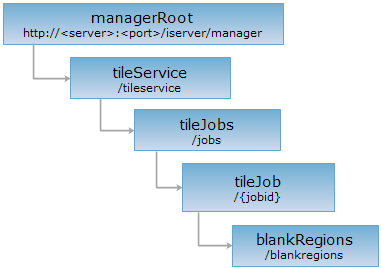URI
<tileJob uri>/blankregions[.<format>]
Supported methods
Parent resource
Child resources
markedBlankRegions, markedNotBlankRegions, unmarkedBlankRegions, allBlankregions, retileJob
Introduction
The statistical blank region information of the specified tile task, including the blank region information for each scale, the blank region number, marked blank region number, marked normal region number, number of regions to be processed, etc. of the current scale. Users can update the statistical blank region information of the specified tile task through the PUT request.
Supported Methods:
- GET: Gets the statistical blank region information of the specified tile task.
- PUT: Updates the statistical blank region information of the specified tile task.
- HEAD: Checks whether the blankRegions resource exists or whether it has permission to access the resource.
Supported output formats: rjson, json, html, xml.
Resource hierarchy

HTTP request methods
Implement the HTTP request on the following URI, where supermapiserver is the server name, with rjson being the output format.
http://localhost:8090/iserver/manager/tileservice/jobs/1dc385d1-a821-448e-8ac8-0a168a73e509/blankregions.rjson
GET request
Gets the statistical blank region information of the specified tile task. The request parameters must be placed in URI.
Request parameter
| Name | Type | Description |
| scale | double | [Required] The display scale of the map. |
Response structure
The returned result for implementing the GET request on the blankRegions resource is as follows:
| Field | Type | Description |
| currentScaleCount | int | The blank region number of the current scale. |
| markedNormal | int | The number of normal regions. |
| markedReTile | int | The number of blank regions need to be retiled. |
| marking | int | The number of regions need to be processed and marked. |
| scaleDenominator | double | The denominator of the current scale. |
| total | int | The total number of blank regions. |
Response example
The rjson format response result returned after implementing the GET request on the blankRegions resource http://localhost:8090/iserver/manager/tileservice/jobs/1dc385d1-a821-448e-8ac8-0a168a73e509/blankregions.rjson?scale=8.333333333333333e-7 is as follows:
{
"currentScaleCount": 1946,
"markedNormal": 0,
"markedReTile": 0,
"marking": 1946,
"scaleDenominator": 1200000,
"total": 1946
}
PUT request
Updates the statistical blank region information of the specified tile task.
Request parameter
Parameters passed in the request body are as follows:
| Field | Type | Description |
| invalidRegionIds | String[] | The array of IDs of blank regions marked as wrong and need to be retiled. |
| validRegionIds | String[] | The array of IDs of blank regions marked as right and need not to be retiled. |
| noneRegionIds | String[] | The array of IDs of blank regions not marked. |
Response structure
The returned representation structure is as follows after implementing the PUT request on the blankRegions resource (representation is in the entity body of the response message):
| Field | Type | Description |
| succeed | boolean | Whether the statistical information of the blank region information of the current tile task has been successfully updated. |
Example usage
Suppose we plan to implement the PUT request on the blankRegions resource http://localhost:8090/iserver/manager/tileservice/jobs/1dc385d1-a821-448e-8ac8-0a168a73e509/blankregions.rjson?scale=8.333333333333333e-7 to update the statistical information of the blank region information of the current tile task, following parameters will be passed in:
{
"invalidRegionIds": ["7c6c8537-12f1-42e4-93a4-30ed0814100a", "0cd3e6e0-96a3-49aa-a53e-15ba887af611"],
"validRegionIds": ["c8f52a39-32f7-4753-9426-be66995495d9", "d66d299f-ba7b-47eb-a3a4-1c063351c18a", "e49ed74d-87dc-4e62-b8dd-8bf2c85f70e6"],
"noneRegionIds": ["1d161fe0-50a0-441a-a594-835b1af93a64"]
}
The response result returned in rjson format is as follows:
{"succeed": true}
HEAD request
Asks for the response identical to the one that would correspond to a GET request, but without the response body. This is useful for retrieving meta-information written in response headers, without having to transport the entire content. The meta-information includes the media-type, content-encoding, transfer-encoding, content-length, etc.
HEAD request can be used to check if the blankRegions resource exists, or if the blankRegions resource can be accessed by clients. It can also determine if the blankRegions resource supports an output format <format> if performed on a URI with .<format> included.